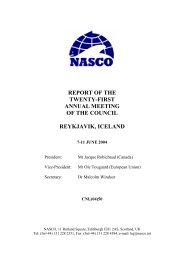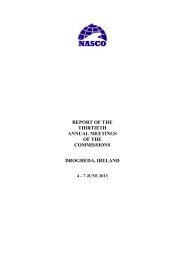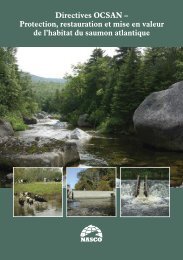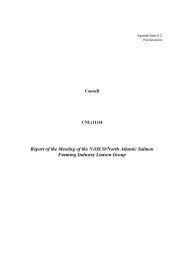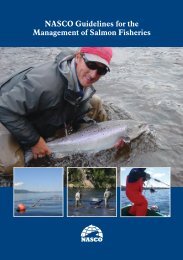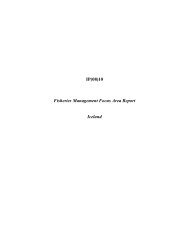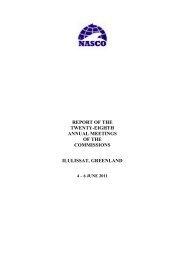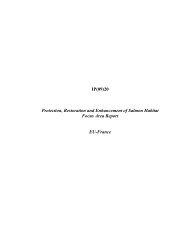Report of the 2005 ICES/NASCO Symposium on Interactions ...
Report of the 2005 ICES/NASCO Symposium on Interactions ...
Report of the 2005 ICES/NASCO Symposium on Interactions ...
You also want an ePaper? Increase the reach of your titles
YUMPU automatically turns print PDFs into web optimized ePapers that Google loves.
NINA SPECIAL REPORT 34<br />
Salm<strong>on</strong> lice infecti<strong>on</strong> <str<strong>on</strong>g>of</str<strong>on</strong>g> running Atlantic<br />
salm<strong>on</strong> in two Norwegian fjords: effects <str<strong>on</strong>g>of</str<strong>on</strong>g><br />
hydrography and lice abundance<br />
Peter Andreas Heuch, Jens Christian Holst, Lars Asplin, Bengt<br />
Finstad, Pål A Bjørn and Audun Stien<br />
Research carried out during <str<strong>on</strong>g>the</str<strong>on</strong>g> 1990s identified salm<strong>on</strong><br />
lice as a potentially serious populati<strong>on</strong>-regulating factor in<br />
Norwegian salm<strong>on</strong>id stocks. Various management<br />
measures were imposed, am<strong>on</strong>gst <str<strong>on</strong>g>the</str<strong>on</strong>g>m a veterinarian act<br />
in 1997 regulating <str<strong>on</strong>g>the</str<strong>on</strong>g> numbers and stages <str<strong>on</strong>g>of</str<strong>on</strong>g> salm<strong>on</strong> lice<br />
allowed per individual fish in farms. Through a<br />
comparative study between two major salm<strong>on</strong> fjords,<br />
Altafjord and Sognefjord, we focused <strong>on</strong> interacti<strong>on</strong>s<br />
between salm<strong>on</strong> lice and wild and farmed salm<strong>on</strong>ids. In<br />
Altafjord <str<strong>on</strong>g>the</str<strong>on</strong>g> results indicate that salm<strong>on</strong> lice were never a<br />
problem for migrating post-smolts <str<strong>on</strong>g>of</str<strong>on</strong>g> salm<strong>on</strong>, while in <str<strong>on</strong>g>the</str<strong>on</strong>g><br />
Sognefjord <str<strong>on</strong>g>the</str<strong>on</strong>g> c<strong>on</strong>diti<strong>on</strong>s have g<strong>on</strong>e from negative before<br />
2002 to good during 2002-2004. This coincides with <str<strong>on</strong>g>the</str<strong>on</strong>g><br />
fish farming industry’s efforts to reduce <str<strong>on</strong>g>the</str<strong>on</strong>g> salm<strong>on</strong> lice<br />
producti<strong>on</strong> in <str<strong>on</strong>g>the</str<strong>on</strong>g> farms in <str<strong>on</strong>g>the</str<strong>on</strong>g> critical spring period.<br />
Hydrographic-biologic modelling <str<strong>on</strong>g>of</str<strong>on</strong>g> data from Sogn from a<br />
three-year period showed that envir<strong>on</strong>mental factors do<br />
not explain <str<strong>on</strong>g>the</str<strong>on</strong>g> reduced infecti<strong>on</strong> <str<strong>on</strong>g>of</str<strong>on</strong>g> <str<strong>on</strong>g>the</str<strong>on</strong>g> running salm<strong>on</strong><br />
smolts. For sea trout <str<strong>on</strong>g>the</str<strong>on</strong>g> situati<strong>on</strong> seems less positive. A<br />
clear reducti<strong>on</strong> <str<strong>on</strong>g>of</str<strong>on</strong>g> salm<strong>on</strong> lice infecti<strong>on</strong> intensity <strong>on</strong> sea<br />
trout was not recorded in ei<str<strong>on</strong>g>the</str<strong>on</strong>g>r <str<strong>on</strong>g>the</str<strong>on</strong>g> Altafjord or in <str<strong>on</strong>g>the</str<strong>on</strong>g><br />
Sognefjord. It is c<strong>on</strong>cluded that wild and farmed salm<strong>on</strong><br />
can coexist in Norwegian fjords if <str<strong>on</strong>g>the</str<strong>on</strong>g> total amount <str<strong>on</strong>g>of</str<strong>on</strong>g><br />
salm<strong>on</strong> lice larvae in <str<strong>on</strong>g>the</str<strong>on</strong>g> fjord is adapted to <str<strong>on</strong>g>the</str<strong>on</strong>g> local<br />
hydrographic c<strong>on</strong>diti<strong>on</strong>s and <str<strong>on</strong>g>the</str<strong>on</strong>g> populati<strong>on</strong> characteristics<br />
<str<strong>on</strong>g>of</str<strong>on</strong>g> <str<strong>on</strong>g>the</str<strong>on</strong>g> wild salm<strong>on</strong>ids. To ensure precauti<strong>on</strong>ary salm<strong>on</strong><br />
lice management in Norwegian fjords <str<strong>on</strong>g>the</str<strong>on</strong>g>re is a need for<br />
more knowledge <strong>on</strong> envir<strong>on</strong>mental and biological<br />
parameters, in particular where <str<strong>on</strong>g>the</str<strong>on</strong>g>re are plans for<br />
increasing <str<strong>on</strong>g>the</str<strong>on</strong>g> output <str<strong>on</strong>g>of</str<strong>on</strong>g> farmed fish.<br />
Two-year sea lice larvae plankt<strong>on</strong> survey<br />
Michael J Penst<strong>on</strong>, Ian M Davies and Alain F Zuur<br />
An extensive plankt<strong>on</strong> survey was carried out in <str<strong>on</strong>g>the</str<strong>on</strong>g> Loch<br />
Torrid<strong>on</strong> system, <strong>on</strong> <str<strong>on</strong>g>the</str<strong>on</strong>g> west coast <str<strong>on</strong>g>of</str<strong>on</strong>g> Scotland, to<br />
investigate sea louse infective pressure. The survey<br />
c<strong>on</strong>sisted <str<strong>on</strong>g>of</str<strong>on</strong>g> plankt<strong>on</strong> tows collected weekly at a number<br />
<str<strong>on</strong>g>of</str<strong>on</strong>g> sites within <str<strong>on</strong>g>the</str<strong>on</strong>g> sea loch over a 2-year period, between<br />
2002 and 2004. In total, 884 samples were collected and<br />
8,382 lice larvae were recovered, <str<strong>on</strong>g>of</str<strong>on</strong>g> which 58% were<br />
nauplii and 42% were copepodids. The species <str<strong>on</strong>g>of</str<strong>on</strong>g> <str<strong>on</strong>g>the</str<strong>on</strong>g><br />
nauplii were not determined, but copepodids were<br />
retained for identificati<strong>on</strong>. From <str<strong>on</strong>g>the</str<strong>on</strong>g> 416 samples<br />
c<strong>on</strong>taining preserved copepodids, a random selecti<strong>on</strong> <str<strong>on</strong>g>of</str<strong>on</strong>g><br />
102 samples were examined for <str<strong>on</strong>g>the</str<strong>on</strong>g> presence <str<strong>on</strong>g>of</str<strong>on</strong>g><br />
Lepeoph<str<strong>on</strong>g>the</str<strong>on</strong>g>irus salm<strong>on</strong>is and Caligus el<strong>on</strong>gatus. The vast<br />
majority <str<strong>on</strong>g>of</str<strong>on</strong>g> <str<strong>on</strong>g>the</str<strong>on</strong>g> copepodids retained were L. salm<strong>on</strong>is, and<br />
<strong>on</strong>ly a few were C. el<strong>on</strong>gatus. During <str<strong>on</strong>g>the</str<strong>on</strong>g> survey, salm<strong>on</strong><br />
fish farms in <str<strong>on</strong>g>the</str<strong>on</strong>g> Loch Torrid<strong>on</strong> system completed a<br />
producti<strong>on</strong> cycle. Generalised Additive Models (GAMs)<br />
were used to describe <str<strong>on</strong>g>the</str<strong>on</strong>g> distributi<strong>on</strong> <str<strong>on</strong>g>of</str<strong>on</strong>g> lice larvae. The<br />
models suggested an increase in larvae densities during<br />
<str<strong>on</strong>g>the</str<strong>on</strong>g> farm producti<strong>on</strong> cycle, followed by a decrease as <str<strong>on</strong>g>the</str<strong>on</strong>g><br />
farms harvested and were left fallow. Significantly greater<br />
densities <str<strong>on</strong>g>of</str<strong>on</strong>g> copepodids were recovered at <str<strong>on</strong>g>the</str<strong>on</strong>g> surface<br />
than at 2.5 and 5 metre depths. Nauplii showed no<br />
preference for any <str<strong>on</strong>g>of</str<strong>on</strong>g> <str<strong>on</strong>g>the</str<strong>on</strong>g> depths sampled. Densities <str<strong>on</strong>g>of</str<strong>on</strong>g><br />
sea lice larvae were found to vary c<strong>on</strong>siderably, ranging<br />
from 0 to 243 larvae m -3 . This high variability in <str<strong>on</strong>g>the</str<strong>on</strong>g> data<br />
was also indicated in <str<strong>on</strong>g>the</str<strong>on</strong>g> GAM models.<br />
The current state <str<strong>on</strong>g>of</str<strong>on</strong>g> health management in<br />
aquaculture - progress to date and future<br />
challenges<br />
Graeme Dear and Edward Brans<strong>on</strong><br />
Fish health management has developed from being a ‘new<br />
c<strong>on</strong>cept/minor species/green-fingered/let’s try it and see’<br />
aspect <str<strong>on</strong>g>of</str<strong>on</strong>g> aquaculture to <strong>on</strong>e which increasingly utilises <str<strong>on</strong>g>the</str<strong>on</strong>g><br />
most advanced scientific technology to provide soluti<strong>on</strong>s<br />
to health challenges. The current status <str<strong>on</strong>g>of</str<strong>on</strong>g> fish health and<br />
opti<strong>on</strong>s available to <str<strong>on</strong>g>the</str<strong>on</strong>g> farmer to c<strong>on</strong>trol pathogens are<br />
described in <str<strong>on</strong>g>the</str<strong>on</strong>g> c<strong>on</strong>text <str<strong>on</strong>g>of</str<strong>on</strong>g> a rapidly evolving industry.<br />
The inter-relati<strong>on</strong>ship between <str<strong>on</strong>g>the</str<strong>on</strong>g> key parameters <str<strong>on</strong>g>of</str<strong>on</strong>g><br />
legislati<strong>on</strong>, ec<strong>on</strong>omics, envir<strong>on</strong>ment, host, c<strong>on</strong>sumer<br />
c<strong>on</strong>cerns and veterinary medicines are examined in <str<strong>on</strong>g>the</str<strong>on</strong>g><br />
c<strong>on</strong>text <str<strong>on</strong>g>of</str<strong>on</strong>g> reducing antibiotic use and increasing pressure<br />
to c<strong>on</strong>trol parasitic and viral diseases such as sea lice,<br />
IPNV and pancreas disease. While vaccine availability and<br />
husbandry methods have advanced to <str<strong>on</strong>g>the</str<strong>on</strong>g> point where<br />
<str<strong>on</strong>g>the</str<strong>on</strong>g>y have reduced, but not eliminated, <str<strong>on</strong>g>the</str<strong>on</strong>g> need for<br />
antibiotics, <str<strong>on</strong>g>the</str<strong>on</strong>g> future challenges revolve around <str<strong>on</strong>g>the</str<strong>on</strong>g><br />
importance <str<strong>on</strong>g>of</str<strong>on</strong>g> a greater understanding <str<strong>on</strong>g>of</str<strong>on</strong>g> <str<strong>on</strong>g>the</str<strong>on</strong>g> needs <str<strong>on</strong>g>of</str<strong>on</strong>g><br />
aquaculture healthcare. In an envir<strong>on</strong>ment which is<br />
increasingly demanding from regulatory, envir<strong>on</strong>mental,<br />
retailer, c<strong>on</strong>sumer and wider stakeholder interests - it is<br />
important not to forget <str<strong>on</strong>g>the</str<strong>on</strong>g> main purpose <str<strong>on</strong>g>of</str<strong>on</strong>g> <str<strong>on</strong>g>the</str<strong>on</strong>g> subject,<br />
i.e. fish health and welfare. These challenges will be<br />
discussed and key areas identified for veterinary care and<br />
future research and development to assist in <str<strong>on</strong>g>the</str<strong>on</strong>g><br />
management <str<strong>on</strong>g>of</str<strong>on</strong>g> fish health.<br />
37



